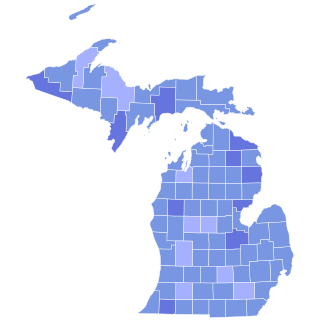Top Qs
Timeline
Chat
Perspective
2020 Michigan Democratic presidential primary
From Wikipedia, the free encyclopedia
Remove ads
The 2020 Michigan Democratic presidential primary took place on March 10, 2020, as one of several states voting the week after Super Tuesday in the Democratic Party primaries for the 2020 presidential election. The Michigan primary was an open primary,[1] with the state awarding 147 delegates towards the 2020 Democratic National Convention, of which 125 were pledged delegates allocated on the basis of the results of the primary.
Former vice president Joe Biden decisively won the primary and every county in the state, getting almost 53% of the vote and 73 delegates. Senator Bernie Sanders received around 36% of the vote and 52 delegates, marking a clear regression in support for him from 2016, when he edged out Hillary Clinton by 1.42% and won 73 of the state's 83 counties.[2] Biden's victory was powered by support from African Americans, older voters, working class voters, and moderate voters.[3]
Despite losing every county and almost all municipalities, Sanders was still able to win some of the major cities in the state including: Ann Arbor, Dearborn, Grand Rapids, Lansing and Kalamazoo.[4]
Remove ads
Procedure
Summarize
Perspective
Michigan was one of six states (along with Democrats Abroad) which held primaries on March 10, 2020, one week after Super Tuesday.[5] Voting took place throughout the state from 7:00 a.m. until 8:00 p.m. local time. In the open primary, candidates had to meet a threshold of 15 percent at the congressional district or statewide level in order to be considered viable. The 125 pledged delegates to the 2020 Democratic National Convention were allocated proportionally on the basis of the results of the primary. Of these, between 4 and 9[6] were allocated to each of the state's 14 congressional districts and another 16 were allocated to party leaders and elected officials (PLEO delegates), in addition to 27 at-large delegates.[7] The March primary as part of Stage I on the primary timetable received no bonus delegates, in order to disperse the primaries between more different date clusters and keep too many states from hoarding on a March date.[8]
After district conventions on May 16, 2020, during which district-level delegates were selected, the state central committee meeting subsequently was held on June 13, 2020, to vote on the 27 at-large and 16 pledged PLEO delegates for the Democratic National Convention. The delegation also included 22 unpledged PLEO delegates: 12 members of the Democratic National Committee, 9 members of Congress (both senators and 7 representatives), and the governor Gretchen Whitmer.[7]
Remove ads
Candidates
The following people have been included on the list issued by the Michigan Secretary of State for the presidential primary.[9]
Running
Withdrawn
There was also an uncommitted option on the ballot.[10]
Remove ads
Polling
Remove ads
Results

Biden—40–50%
Biden—50–60%
Biden—60–70%
Remove ads
See also
Notes
Summarize
Perspective
Additional candidates
- Candidate withdrew during absentee voting, following the New Hampshire primary.
- Candidate withdrew during absentee voting, following Super Tuesday.
- Candidate withdrew during absentee voting, before Super Tuesday.
- Candidate withdrew in January, shortly after absentee voting had begun.
- Calculated by taking the difference of 100% and all other candidates combined
- FiveThirtyEight aggregates polls with a trendline regression of polls rather than a strict average of recent polls.
- Key:
A – all adults
RV – registered voters
LV – likely voters
V – unclear - Gabbard with 1%; "Other" with 9%
- Gabbard with 2%; "Other" with 1%
- Gabbard with 2%
- Steyer with 1%; "Someone else" with 2%
- Steyer with 0%; "Other" with 1%; "Uncommitted" with 3%
- Gabbard with 1%
- Part of a 1,750 registered voter poll of Michigan, Pennsylvania, and Wisconsin
- Gabbard with 1%; Steyer with 0%; "Uncommitted" with 6%
- Listed as "undecided/would not vote"
- "Other" with 9%
- "Declined" with 13%
- Gabbard with 1%; Bennet, Booker, Delaney, Steyer, and Williamson with 0%; Castro and Sestak with no voters; "Refused" with 5%
- "Not sure/other" with 14%
- Steyer with 1.7%; Delaney with 1.6%; Bennet with 0.8%; Gabbard with 0.7%; Patrick with 0.5%
- Gabbard with 1%; Bennet, Bullock, Castro, Delaney, Sestak, and Williamson with 0%; Someone else with 2%
- Gabbard with 1%; others with 0%
- Castro and Steyer with no voters; someone else with 0%
- Bennet with 2%; Gabbard, Delaney with 1%; Bullock, Castro, Messam, Ryan, Sestak, Steyer and Williamson with 0%
- Labelled as "Other/unsure"
- Gabbard and Steyer with 1%; Bennet, de Blasio, Bullock, Castro, Delaney, Gillibrand, Gravel, Hickenlooper, Inslee, Messam, Moulton, Ryan, Sestak and Williamson with 0%
- Labelled as "Other/unsure"
- Castro, Delaney, Gabbard, Gillibrand, and Hickenlooper with 1%; Inslee with 0%
- Bennet, Gabbard, Gillibrand, and Swalwell with 1%; Castro, Delaney, Gravel, Hickenlooper, Inslee, Messam, Moulton, Ryan, Williamson, and Yang with 0%
- Gillibrand and Hickenlooper with 1%; Castro, Gabbard, and Inslee with 0%; others with 3%
Remove ads
References
External links
Wikiwand - on
Seamless Wikipedia browsing. On steroids.
Remove ads



